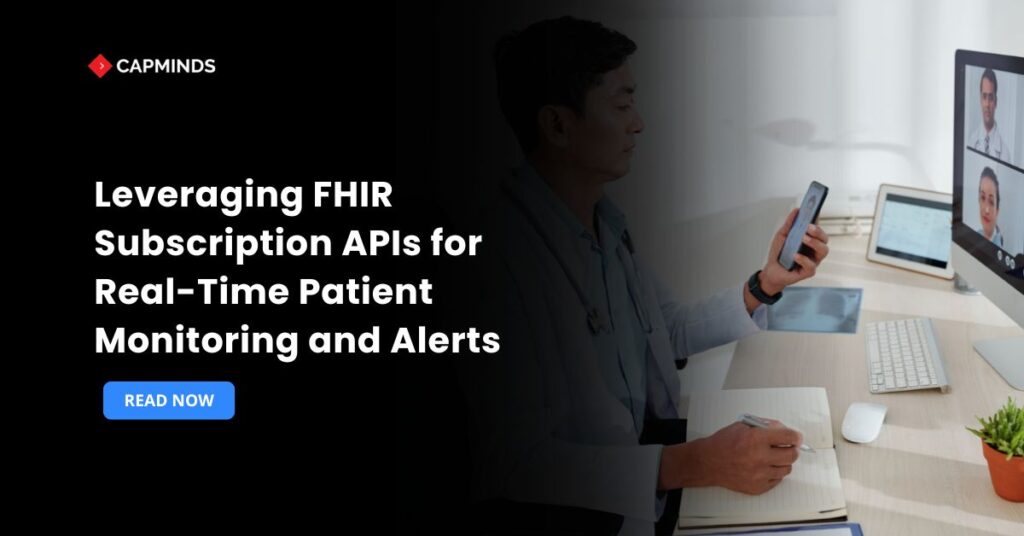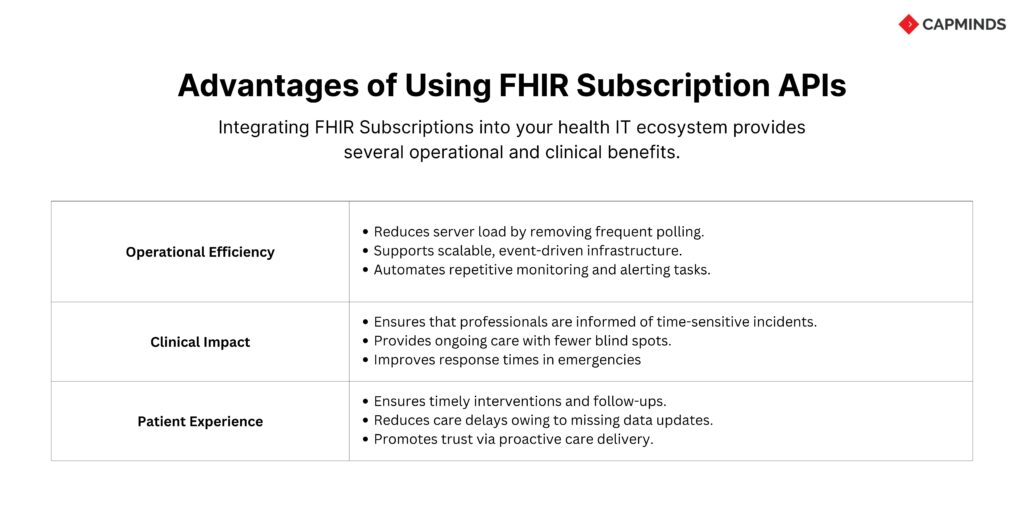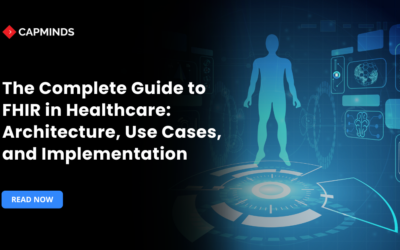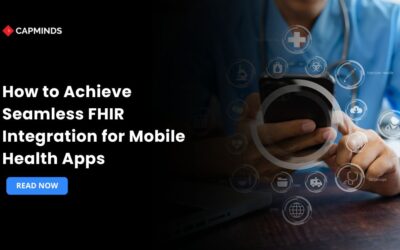Leveraging FHIR Subscription APIs for Real-Time Patient Monitoring and Alerts
Timely access to patient data can make the difference between proactive care and serious delays in the linked healthcare environment. As healthcare companies strive for real-time interoperability, Fast Healthcare Interoperability Resources Subscription APIs have emerged as an effective tool for automating notifications, triggering clinical workflows, and improving patient outcomes.
Whether it’s a rapid increase in a patient’s vital signs or a change in test findings, FHIR Subscriptions may notify care teams without requiring manual involvement.
In this blog, you’ll know how FHIR Subscription APIs provide real-time patient monitoring and intelligent alerting, allowing healthcare providers to keep one step ahead.
What are the FHIR Subscription APIs?
FHIR Subscription APIs are part of the HL7 FHIR standard and enable clients to be notified when particular changes occur in FHIR resources. Instead of continually asking servers for changes, clients may subscribe to events and receive real-time alerts via REST hooks, email, SMS, and even WebSockets.
FHIR Subscriptions Work:
- The client creates a criteria-based subscription, like Inform me if a patient’s blood pressure exceeds 140/90.
- The FHIR server monitors relevant resources and sends a notice when the condition is satisfied.
- The server sends the alert to the client via the specified delivery channel.
For high-frequency patient monitoring, especially in inpatient and chronic care settings, this approach enables an asynchronous, event-driven architecture in healthcare systems.
The Shift from Batch to Real-Time: Why it Matters
Traditional healthcare systems rely heavily on batch processing and periodic data updates, which are frequently too slow for critical clinical situations. These delays can lead to missed early warning signals, particularly for critical care patients and those with complicated diseases.
In contrast, FHIR Subscription APIs allow a push-based architecture, which enables:
- Immediate notification of changes in vital signs, test findings, or medicine orders
- Quicker clinical reaction times
- Reduced need for manual chart checks or data refresh cycles.
By adopting real-time interoperability via subscriptions, hospitals and digital health platforms may deliver better, quicker, and more coordinated treatment.
Real-time Patient Monitoring: Use Cases for FHIR Subscriptions
FHIR Subscription APIs are especially effective when used in patient monitoring systems, remote patient management platforms, and inpatient care settings.
1. Vital Sign Threshold Alert
Healthcare providers can enroll in FHIR Observation services to get real-time notifications when vital signs exceed predetermined thresholds.
Watch out if your systolic blood pressure exceeds 160 or your oxygen saturation falls below 92%.
Impact: Immediate care team action before decline.
2. Monitoring Administration Tracking
Adherence may be ensured, and missed doses can be detected using real-time monitoring of FHIR drug administration tools.
If a vital prescription has not been administered, send a reminder or alarm.
Impact: Better adherence and fewer drug errors.
3. Lab Result Notifications
FHIR DiagnosticReport subscriptions can alert providers when certain test readings are problematic.
Alert if blood glucose levels exceed 200 mg/dL.
Impact: Quicker diagnosis and response to emerging health issues.
4. Hospital Discharge or Admission Events
Track Encounter resources to set up workflows for discharge planning, readmission prevention, and care transitions.
Notify case managers when a patient is released.
Impact: Improved cooperation between care teams and external providers.
Technical Implementation: Setting up FHIR subscriptions
Collaboration between client apps, FHIR servers, and backend processes is required for FHIR subscriptions.
The R4+ Subscription resource, which enables filtering and customized delivery methods, is available on the majority of modern FHIR servers, such as HAPI FHIR, Microsoft Azure FHIR, and Google Cloud Healthcare API.
Key Actions for Implementation
- Define the Subscription – Choose the FHIR resource like Observation, the delivery channel like REST hook, and the filter criteria such as vital sign code.
- Register Endpoint – The client has to provide an endpoint or handler to get alerts.
- Manage Notifications – When a notification payload, such as a Ping or Bundle, is provided by the server, the client parses it and reacts.
- Secure the Connection – Use OAuth2, mTLS, or other secure protocols to protect patient data while it’s being sent.
In FHIR R5, use SubscriptionStatus and SubscriptionTopic to improve topic-based filtering and granular event delivery.
Advantages of Using FHIR Subscription APIs
Integrating FHIR Subscriptions into your health IT ecosystem provides several operational and clinical benefits. This includes:
Operational Efficiency
- Reduces server load by removing frequent polling.
- Supports scalable, event-driven infrastructure.
- Automates repetitive monitoring and alerting tasks.
Clinical Impact
- Ensures that professionals are informed of time-sensitive incidents.
- Provides ongoing care with fewer blind spots.
- Improves response times in emergencies
Patient Experience
- Ensures timely interventions and follow-ups.
- Reduces care delays owing to missing data updates.
- Promotes trust via proactive care delivery.
Overcoming the Implementation Challenges
Despite the advantages, there are a number of challenges in widely implementing FHIR Subscriptions. It is essential to comprehend and prepare for these difficulties.
Common Challenges
- Data Noise – Poorly designed subscriptions might cause alert fatigue owing to numerous alerts.
- Integration Complexity – Subscriptions necessitate tight integration of healthcare systems, EHRs, and FHIR APIs.
- Risks to Security and Privacy– Without sufficient controls, event-based data transfer might raise the danger of exposure.
Recommendations
- Use specific criteria and filters to avoid needless notifications.
- Build a robust retry and queue system for the client-side application.
- Use data handling procedures that comply with HIPAA, such as access logging and encryption.
Related: How to Align FHIR API Development With USCDI and TEFCA Compliance
Empower Real-Time Care with CapMinds: FHIR Subscriptions & Beyond
At CapMinds, we turn real-time patient monitoring from a complex challenge into a powerful advantage. With our end-to-end digital health tech services, you can seamlessly implement FHIR Subscription APIs to drive instant alerts, automate clinical workflows, and boost patient outcomes.
Whether you’re building an inpatient alert system, remote monitoring app, or smart care dashboard, we’ve got you covered.
Our FHIR & Real-Time Care Services Include:
- FHIR Subscription API Implementation & Customization
- Real-Time Vital Sign & Lab Alerts via HL7 & FHIR
- Remote Patient Monitoring Solutions
- Secure API Integration with EHR, LIS, and IoT Devices
- HL7/FHIR Gateway Setup for Event-Driven Workflows
- HIPAA-Compliant Cloud Infrastructure & DevOps
Let CapMinds power your journey to intelligent, real-time healthcare.
Reach out today to integrate smarter, faster care, one event at a time.





